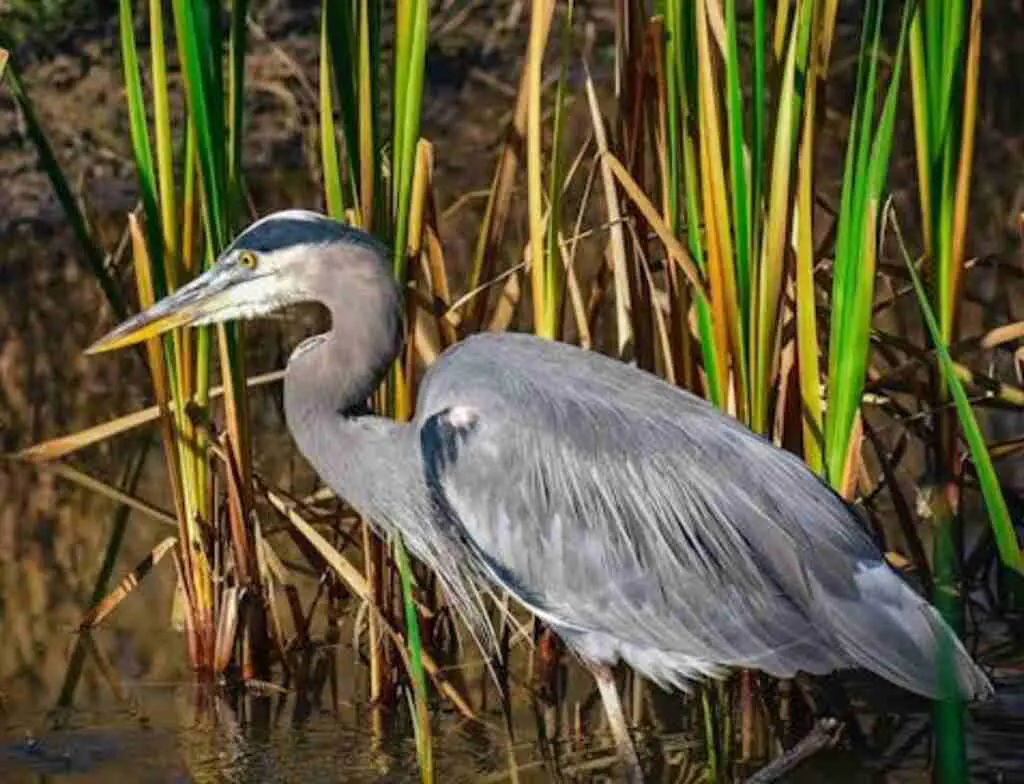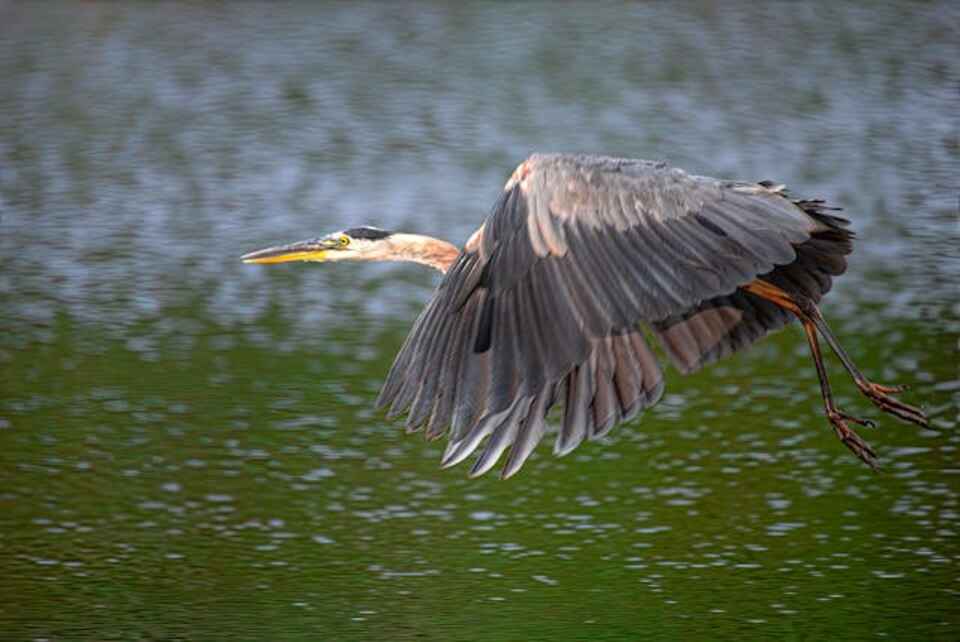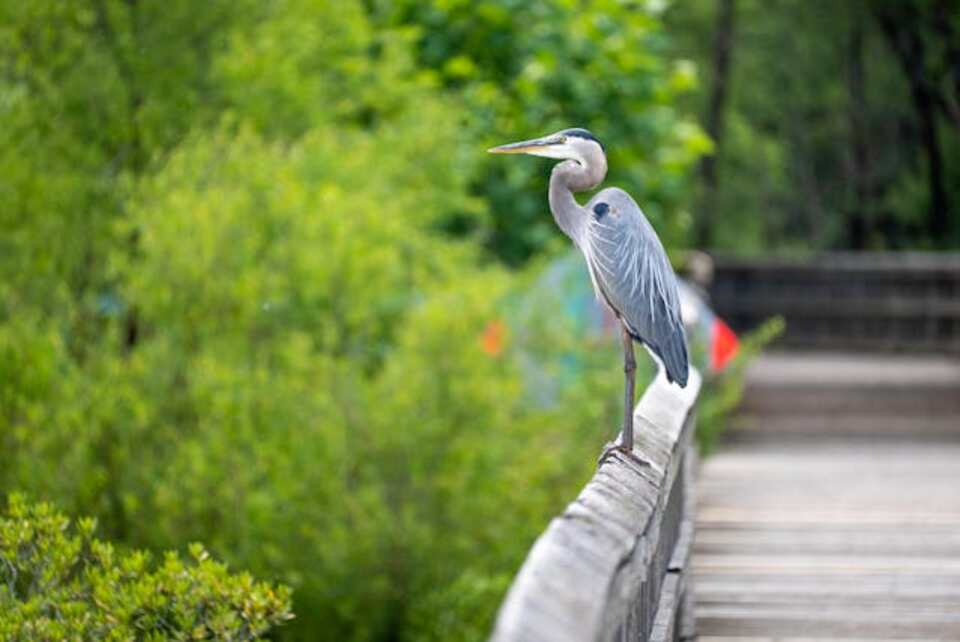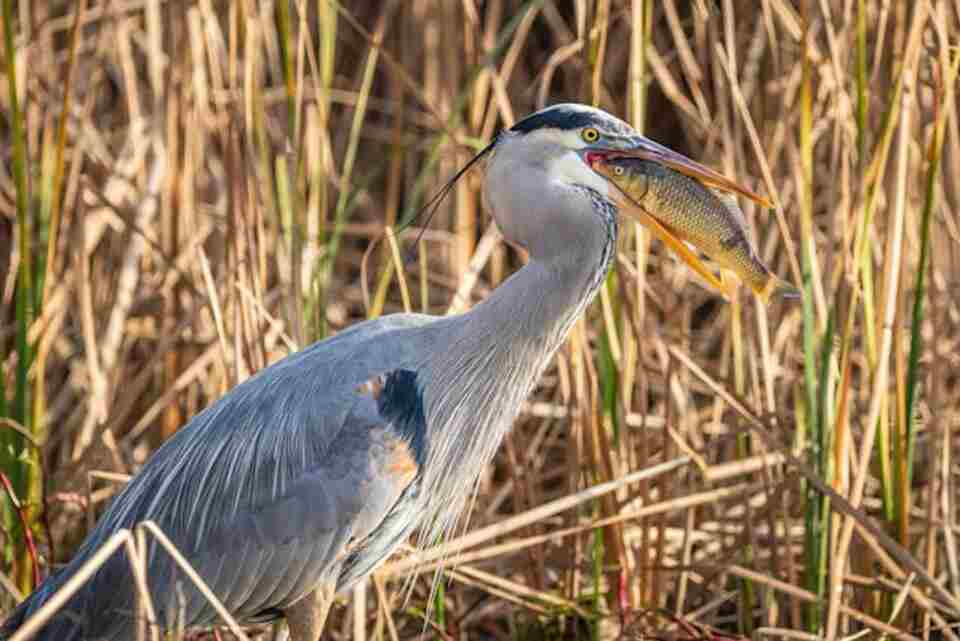The Great Blue Heron (Ardea herodias) is a captivating and iconic wading bird found throughout North America. With its towering stature, graceful movements, and striking plumage, the Great Blue Heron has captured the imagination of birdwatchers, nature enthusiasts, and environmentalists alike. In this comprehensive guide, we’ll delve into the fascinating world of this avian marvel, exploring its physical characteristics, habitat, behavior, and more.
Table of Contents
Distinctive Features: A Heron Unlike Any Other
The Great Blue Heron is a true standout in the avian kingdom, with its unique physical attributes setting it apart from other heron species.
Towering Stature
| Measurement | Range |
|---|---|
| Length | 115-137 cm (45-54 inches) |
| Wingspan | 167-201 cm (66-79 inches) |
| Weight | 2-4 kg (4.4-8.8 lbs) |
The Great Blue Heron is one of the largest heron species in North America, with a tall, slender build that can reach impressive heights. Its long, graceful neck and legs contribute to its majestic appearance, making it a true sight to behold.
Striking Plumage
The Great Blue Heron’s plumage is a symphony of subtle shades and striking contrasts:
- Head and Neck: Slate-blue with a distinctive white stripe running down the center of the neck.
- Back and Wings: Slate-blue, with some darker feathers creating a “shawl” effect on the back.
- Underparts: White, with a black stripe running down the center of the belly.
- Bill: Long, sharp, and pointed, perfectly adapted for spearing fish and other prey.
- Legs: Yellowish-green, adding to the bird’s striking appearance.
This elegant color pattern not only makes the heron visually stunning but also helps it blend seamlessly into its wetland habitats.
Specialized Feet
The Great Blue Heron’s feet are specially adapted for its wading lifestyle:
- Toes: Long and slender, with sharp, curved claws that provide traction on slippery surfaces.
- Webbing: Partial webbing between the toes, allowing the heron to move easily through shallow water.
- Balance: The heron’s large, flat feet distribute its weight, enabling it to stand in deep water without sinking.
These specialized feet are essential for the heron’s hunting and foraging techniques, allowing it to navigate treacherous wetland environments with ease.
Habitat and Distribution: A Wide-Ranging Bird
The Great Blue Heron is a widely distributed species, found across a vast geographical range in North America.
Preferred Habitats
Great Blue Herons thrive in a variety of wetland environments, including:
- Freshwater Wetlands: Marshes, swamps, ponds, and the shallow edges of lakes and rivers.
- Saltwater Habitats: Estuaries, tidal flats, and the shorelines of oceans and bays.
- Artificial Waterbodies: Reservoirs, sewage treatment ponds, and other man-made water features.
These birds prefer habitats with abundant prey, such as fish, amphibians, and small mammals, as well as suitable nesting sites, often in the form of trees or other tall structures.
Geographic Range
The Great Blue Heron’s range spans across North America, with both resident and migratory populations:
- Year-round Range: Found throughout the continental United States, as well as in parts of Canada and Mexico.
- Migratory Populations: Breed in northern parts of the range and migrate south for the winter.
- Expansion and Adaptation: The heron has adapted to urban and suburban areas, expanding its range to include man-made wetlands and water features.
This broad distribution and adaptability have allowed the Great Blue Heron to thrive in a variety of ecosystems across the continent.
Feeding Habits: A Skilled Predator
The Great Blue Heron is a highly specialized predator, with a diverse diet and an array of hunting techniques.
Prey Preferences
The heron’s diet consists primarily of:
- Fish: A wide variety of freshwater and saltwater species, including small to medium-sized fish.
- Amphibians: Frogs, tadpoles, and salamanders.
- Crustaceans: Crabs, crayfish, and shrimp.
- Small Mammals: Voles, mice, and even young muskrats.
- Insects: Dragonflies, damselflies, and other aquatic insects.
The heron’s diet can vary depending on the availability of prey in its local habitat.
Hunting Techniques
Great Blue Herons employ a range of specialized hunting strategies:
- Wading: Slowly stalking through shallow water, using its long legs and keen eyesight to spot and capture prey.
- Standing and Waiting: Remaining motionless and patient, ready to strike when the opportunity arises.
- Plunge Diving: Diving from a perch or the air to catch fish swimming in deeper water.
- Aerial Hunting: Soaring over wetlands and pouncing on unsuspecting prey.
- Cooperative Hunting: Working in small groups to herd and trap fish in shallow areas.
The heron’s long, sharp bill is a formidable tool, allowing it to spear and impale its prey with precision.
Foraging Behavior
Great Blue Herons are highly adaptable foragers, adjusting their techniques based on the habitat and available prey:
- Freshwater: Wading in shallow ponds and streams, stalking and striking fish, amphibians, and small mammals.
- Saltwater: Hunting in tidal flats, estuaries, and along coastlines, targeting crustaceans and marine fish.
- Urban Areas: Foraging in man-made water features, such as ornamental ponds and retention basins.
Their ability to thrive in diverse environments is a testament to their ecological versatility.
Social Behavior and Breeding
The social dynamics and breeding habits of the Great Blue Heron are equally fascinating.
Social Structure
Great Blue Herons are generally solitary outside the breeding season, but they may form small, loose flocks while foraging or during migration. During the breeding season, they come together in large, communal nesting colonies, known as heronries.
Courtship and Nesting
The courtship rituals of the Great Blue Heron involve an array of behaviors:
- Bill Clicking: Males engage in a rapid “bill-clapping” display to attract females.
- Wing-Spreading: Spreading their wings to show off their impressive size and plumage.
- Nest Building: Constructing large, stick-built nests high in trees or on other elevated structures.
- Pair Bonding: Forming monogamous pairs that may remain together for multiple breeding seasons.
Heronries can contain hundreds of nests, with birds nesting in close proximity to one another.
Egg Laying and Incubation
Great Blue Herons typically lay 3-5 pale blue-green eggs per clutch. Both the male and female participate in the incubation process, which lasts around 25-29 days.
Chick Rearing
Heron chicks are altricial, meaning they hatch helpless and dependent on their parents. The parents take turns feeding and caring for the young, which fledge after approximately 2 months.
Threats and Challenges
While Great Blue Herons are generally not considered threatened, they do face various threats, including:
- Habitat Loss: Wetland degradation and development can disrupt nesting sites and foraging areas.
- Human Disturbance: Recreational activities, such as boating and hiking, can disrupt breeding colonies.
- Pollution: Contaminants in the water can bioaccumulate in the heron’s prey, affecting their health.
- Climate Change: Shifting weather patterns and rising sea levels may impact the heron’s breeding and migration patterns.
Conservation efforts aim to protect wetland habitats and minimize human interference in known breeding colonies.
Cultural Significance and Symbolism
The Great Blue Heron has long held a place in the cultural imagination, inspiring art, literature, and mythology across North America.
Native American Traditions
In many Native American cultures, the Great Blue Heron is revered as a symbol of patience, wisdom, and connection to the natural world. It features prominently in the stories and creation myths of various tribes.
Artistic Representations
The heron’s striking appearance and graceful movements have made it a popular subject in art, from the paintings of John James Audubon to contemporary wildlife photography and sculpture.
Environmental Symbolism
The Great Blue Heron is often used as a symbol of wetland conservation and environmental stewardship, representing the importance of protecting fragile aquatic ecosystems.
Personal Significance
For many people, encountering a Great Blue Heron in the wild can be a truly awe-inspiring and transformative experience, sparking a deeper connection to nature and a sense of wonder.
Observing Great Blue Herons: Tips for Birdwatchers
For those interested in observing Great Blue Herons in their natural habitats, here are some helpful tips and considerations.
When and Where to Look
- Timing: Best observed year-round, with peak activity during the breeding season (spring and summer).
- Habitat: Focus your search on wetland areas, such as marshes, ponds, lakes, and coastlines.
- Geographic Hotspots: Look for herons in areas with large, protected wetlands, such as national wildlife refuges and state parks.
Observation Techniques
- Visual Identification: Scan the water’s edge and tree tops for the heron’s distinctive silhouette and plumage.
- Auditory Clues: Listen for the heron’s deep, croaking calls, especially during the breeding season.
- Behavioral Cues: Watch for the heron’s slow, methodical stalking, as well as its impressive flight and plunge-diving techniques.
Equipment and Preparation
- Binoculars: High-quality 8x or 10x magnification binoculars are ideal for observing herons.
- Spotting Scope: Useful for long-distance observations and studying bird behavior in detail.
- Camera: Bring a camera with a telephoto lens to capture stunning images of these majestic birds.
- Field Guide: A comprehensive bird identification guide will help you confirm your observations.
- Proper Attire: Wear neutral-colored, comfortable clothing and footwear suitable for the terrain.
Ethical Birdwatching
- Respect Nesting Sites: Avoid disturbing active heron colonies, as this can disrupt breeding and nesting activities.
- Maintain Distance: Observe herons from a safe and respectful distance to avoid flushing or stressing the birds.
- Follow Local Regulations: Adhere to any rules or restrictions in place at the specific observation site.
- Minimize Disturbance: Keep noise and movement to a minimum, and avoid using playback or other methods that could disrupt the birds.
- Support Conservation: Consider participating in citizen science projects or donating to organizations that work to protect heron habitats.
By following these guidelines, birdwatchers can enjoy the splendor of the Great Blue Heron while contributing to the ongoing efforts to conserve these magnificent birds and their fragile wetland ecosystems.
Conclusion: Guardians of the Wetlands
The Great Blue Heron stands as a majestic symbol of the delicate balance between man and nature. Its towering presence, graceful movements, and adaptability to diverse habitats have captivated the human imagination for centuries, inspiring art, literature, and a deep appreciation for the natural world.
As we face the challenges of a rapidly changing environment, the conservation of the Great Blue Heron and its wetland habitats becomes increasingly crucial. These birds serve as vital indicators of the health of our aquatic ecosystems, their well-being reflecting the state of the waterways and marshes they call home.
Through responsible observation, education, and advocacy, we can ensure that the Great Blue Heron continues to grace our landscapes for generations to come. By protecting these birds and their fragile environments, we not only safeguard the future of the heron but also preserve the delicate web of life that sustains us all.
So, the next time you catch sight of a Great Blue Heron, standing tall and alert in a tranquil wetland, take a moment to marvel at its beauty and reflect on the importance of preserving the natural wonders that surround us. For in doing so, we not only honor the legacy of this magnificent bird but also secure the health and vibrancy of our shared planet.






